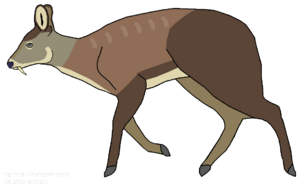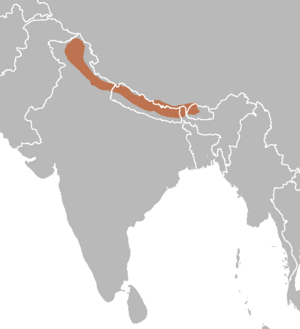White-bellied musk deer facts for kids
Quick facts for kids White-bellied musk deer |
|
|---|---|
 |
|
| Conservation status | |
| Scientific classification | |
| Genus: |
Moschus
|
| Species: |
leucogaster
|
 |
|
| Distribution | |
The white-bellied musk deer or Himalayan musk deer (Moschus leucogaster) is a special kind of musk deer that lives in the Himalayas. You can find it in countries like Nepal, Bhutan, India, Pakistan, and China. This deer is currently listed as endangered, which means its population is shrinking. This is mainly because too many of them have been hunted for their valuable musk.
It used to be thought of as a type of Alpine musk deer, but scientists found differences in their skulls, so now it's considered its own species.
Contents
Amazing Adaptations of the Musk Deer
White-bellied musk deer are super good at living in high mountains. They have special features like strong dew claws and wide toes. These help them stay steady on steep, rocky slopes. They also have a thick coat of coarse hair. This hair is filled with air, which acts like insulation to keep them warm in very cold temperatures.
Unlike other deer, musk deer do not have antlers. Instead, they have two long, sharp teeth called canines. These canines can grow up to about 10 centimeters (4 inches) long. They are quite fragile and can break easily.
These deer have a stocky body shape. Their back legs are much longer and stronger than their front legs. Instead of running or leaping, they tend to "bound" or jump around. Young musk deer, called fawns, have white spots on their fur. These spots help them blend in with their surroundings. As they get older, these spots disappear.
What is Musk?
Male white-bellied musk deer have a special gland in their belly. This gland produces a waxy substance called musk. The deer use this strong-smelling musk to mark territories and to attract female deer. People also use musk to make perfumes and some medicines.
Where Do Musk Deer Live?
Himalayan musk deer live in parts of northern Afghanistan, Pakistan, Tibet, Nepal, Bhutan, and northern India. This includes areas like Jammu and Kashmir, Himachal Pradesh, Uttarakhand, Sikkim, and Arunachal Pradesh. They prefer to live in high alpine areas, usually above 2,500 meters (8,200 feet) in altitude.
Daily Life of a Musk Deer
During the day, white-bellied musk deer are very shy and secretive. They hide in thick bushes and trees. At night, they come out to find food in more open areas. They mostly eat leaves from trees and shrubs that are high in protein. In winter, when fresh leaves are scarce, they eat poorer quality foods like lichens. They can even climb small trees to reach leaves that are usually too high.
Home and Territory
These deer usually stay in a small area, called a home range, which can be up to 22 hectares (about 54 acres). Male musk deer are very protective of their territory. They only let female deer enter their space. They mark their territory by leaving droppings in specific spots and by rubbing strong-smelling secretions onto plants around them.
Reproduction and Life Cycle
During the mating season, male deer fight each other to win over females. They use their long canines to fight and defend their territories. The females usually hide during all this commotion. To attract the females out of hiding, the males use their strong-smelling musk.
A female deer usually gives birth to one or two young at a time. The young musk deer drink their mother's milk until they are about six months old. After that, they can start eating regular food found in the wild. They become old enough to have their own babies when they are 16 to 24 months old.
Himalayan musk deer can live for a long time, usually between 10 and 14 years.
Who Hunts the Musk Deer?
The main predators of the white-bellied musk deer include leopards, snow leopards, lynx, red foxes, and gray wolves. Young musk deer can also be hunted by yellow-throated martens and large birds of prey.
Why Musk Deer Are in Danger
The biggest threat to the white-bellied musk deer is hunting. The musk produced by the male deer is very valuable. It is used to make expensive perfumes and medicines. Because the deer are endangered and hard to find, their value on the illegal wildlife market goes up even more.
Hunters catch and kill the deer using traps called snares. Only male deer produce musk, but these traps often catch females and young deer too, which leads to more deaths. Deer musk can sell for as much as $45,000 per kilogram, making it one of the most valuable animal products in the world.
Protecting the Musk Deer
The white-bellied musk deer is protected by law in countries like Bhutan, Nepal, and India. In China, hunting might be allowed in some areas, but you need a special license. It is also listed as an endangered species in Pakistan. These deer are found in many protected areas. However, laws are not always enforced well across all the places where they live. This makes it hard to stop the illegal trade of the species. A key goal for protecting these deer is to improve how anti-poaching laws are put into action.
What Efforts Are Being Made?
In China, people have started farming musk deer in captivity. This has shown that it is possible to get musk from a deer without killing it. However, deer raised in captivity can get sick easily and fight with each other. They also produce musk that is not as good quality. Because of this, killing wild deer is still seen as the cheapest way to get musk.
A new idea is "open farming." This would involve catching wild musk deer, taking their musk, and then letting them go back into the wild. This method could help protect the species while still allowing for musk collection.
See also
- Kedarnath Wild Life Sanctuary
- Askot Musk Deer Sanctuary


